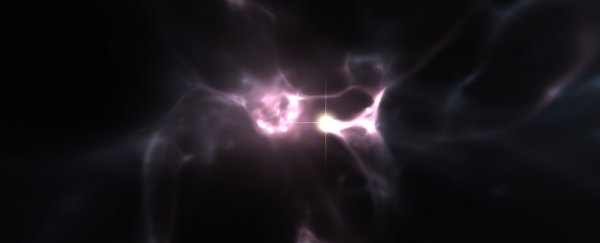Another ancient star has been found lurking in the Milky Way. Around 35,000 light-years away, a red giant star named SMSS J160540.18–144323.1 was found to have the lowest iron levels of any star yet analysed in the galaxy.
This means that it's one of the oldest stars in the Universe, probably belonging to the second generation of stars after the Universe burst into existence 13.8 billion years ago.
"This incredibly anaemic star, which likely formed just a few hundred million years after the Big Bang, has iron levels 1.5 million times lower than that of the Sun," explained astronomer Thomas Nordlander of the ARC Centre of Excellence for All Sky Astrophysics in 3 Dimensions and the Australian National University.
"That's like one drop of water in an Olympic swimming pool."
And that's how we can tell how old the star is, because the very early Universe had no metals at all. The first stars were made up primarily of hydrogen and helium, and were thought to be very massive, very hot, and very short-lived. These stars are called Population III, and we've never seen them.
Stars are 'powered' by nuclear fusion, where the atomic nuclei of lighter elements are combined to create heavier ones. In smaller stars, that's mainly the fusion of hydrogen into helium. But in larger stars - such as the Population III stars are thought to have been - elements up to and including silicon and iron can be forged.
When such stars end their lives in spectacular supernova explosions, they spew those elements out into the Universe. As new stars form, the elements get caught up in them - and thus, how much metal a star contains is a reliable indicator of when it formed.
For example, we know that the Sun is several - perhaps 100 - generations from the Big Bang, based on our star's metallicity.
But we've found other stars in the Milky Way that have a low metallicity, indicating an early Universe origin. One such object is 2MASS J18082002–5104378 B, the previous record-holder for the lowest iron content of [Fe/H] = −4.07 ± 0.07 - around 11,750 times less metallic than the Sun.
But SMSS J160540.18–144323.1 is at [Fe/H] = −6.2 ± 0.2. As Nordlander said, that's around 1.5 million times less metallic.
It's unlikely any Population III stars survived long enough for us to study them. But through the stars that came after, their stories can be unravelled.
The researchers believe that the star that gave SMSS J160540.18–144323.1 its iron was relatively low mass for the early Universe, only around 10 times the mass of the Sun. This is massive enough to produce a neutron star; and, after a comparatively weak supernova, the team believes this is what it did.
A supernova explosion can trigger a rapid neutron-capture process, or r-process. This is a series of nuclear reactions in which atomic nuclei collide with neutrons to synthesise elements heavier than iron.
There was no significant evidence of these elements in the star, which could mean that these elements were captured back by the newly dead neutron star. But enough iron escaped that it was incorporated into the formation of SMSS J160540.18–144323.1.
It was likely one of the very first members of that second generation of stars.
And it's dying. It's a red giant, which means the star is at the very end of its lifespan, using up the last of its hydrogen before it switches to helium fusion.
The team believes that studying it more closely could yield even more information about Population III stars. But imagine the stories it could tell if it could talk.
The research has been published in the Monthly Notices of the Royal Astronomical Society.
A version of this story was first published in August 2019.
